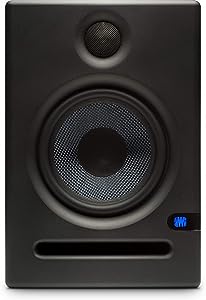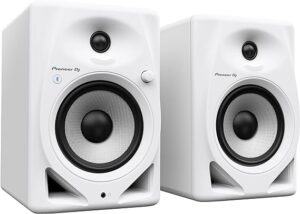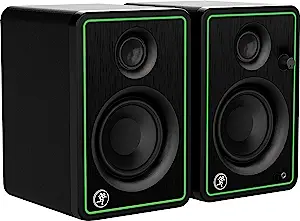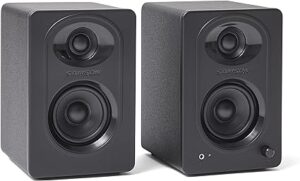In the digital age, the role of studio monitors cannot be overstated. These precision tools serve as the ears of a sound engineer, delivering an accurate and unaltered representation of audio. As technology continues to advance, the landscape of studio monitors evolves, presenting both opportunities and challenges for those seeking excellence in sound reproduction.
Product at a Glance
 |
PreSonus Eris E5 | Check Price |
 |
JBL Professional C1PRO | Check Price |
 |
Pioneer DJ DM-50D-BT-W | Check Price |
 |
Mackie CR-X Series | Check Price |
 |
Samson SAM30 | Check Price |
5 Top Rated Studio Monitors For Music Production
Embark on a comprehensive journey into the world of studio monitors as we unveil the 5 Top Rated Studio Monitors of the year. From precision and accuracy to power handling and connectivity options, our buying guide goes beyond the surface, providing a detailed look at the monitors that have earned top marks in the industry.
Whether you’re a sound engineer seeking unparalleled performance or a music enthusiast aiming for the perfect audio setup, our curated list covers a diverse range of studio monitors to cater to your unique needs. Furthermore, we delve into specific categories such as budget-friendly options, professional-grade monitors, and those ideal for home studios.
Let’s explore some of the best options, offering a blend of features that will undoubtedly elevate your audio production experience.
1. PreSonus Eris E5
 |
PreSonus Eris E5 | Check Price |
The PreSonus Eris E5 takes center stage with a host of features that cater to the discerning audio enthusiast. Boasting a 5.25-inch woven composite low-frequency driver and a 1-inch silk-dome tweeter, the Eris E5 delivers a frequency response of 53 Hz to 22 kHz, ensuring a balanced and accurate representation of audio. The 80W Class AB amplification provides ample power for precise sound reproduction. Equipped with adjustable acoustic space settings, users can fine-tune the monitors to match the acoustics of their room.
The Eris E5 further stands out with its user-friendly controls, including a continuously variable high-pass filter and input gain. With both balanced XLR and 1/4-inch TRS inputs, as well as unbalanced RCA inputs, the Eris E5 offers versatile connectivity options. Whether you’re a music producer, sound engineer, or audiophile, the PreSonus Eris E5 emerges as a formidable choice, promising a compelling blend of performance, accuracy, and adaptability for your studio environment.
Pros
|
Cons
|
2. JBL Professional C1PRO
 |
JBL Professional C1PRO | Check Price |
Now, let’s turn our attention to the JBL Professional C1PRO, a studio monitor that commands attention with its distinctive features and performance attributes. The C1PRO is equipped with a 5-inch low-frequency driver and a 0.75-inch silk-dome high-frequency driver, delivering a frequency response of 60 Hz to 20 kHz. With 150W of total power, this monitor ensures a robust and clear audio output, making it suitable for a range of professional applications.
The front-panel volume control allows for convenient adjustments, while the front-panel headphone jack provides a direct and accessible monitoring option. This can easily set up the wireless headphones as well as per the requirements.
What sets the C1PRO apart is its versatile mounting options, catering to various studio setups. Whether wall-mounted, corner-mounted, or placed on a studio monitor stand, the C1PRO adapts to your spatial constraints without compromising audio quality. With a balanced combination of power, precision, and adaptability, the JBL Professional C1PRO asserts itself as a reliable companion for audio professionals and enthusiasts alike, promising an immersive and accurate listening experience.
Pros
|
Cons
|
3. Pioneer DJ DM-50D-BT-W
 |
Pioneer DJ DM-50D-BT-W | Check Price |
The Pioneer DJ DM-50D-BT-W stands out as a versatile and modern addition to the audio professional’s toolkit. Featuring a 5.25-inch aluminum woofer and a 1-inch soft dome tweeter, this monitor delivers a frequency response of 50 Hz to 20 kHz, ensuring a well-balanced sonic experience. What sets the DM-50D-BT-W apart is its integration of Bluetooth technology, allowing seamless wireless connectivity for audio playback.
With 30W of Class AB amplification per speaker, it strikes a harmonious balance between power and precision. The inclusion of a 3-band EQ allows users to tailor the sound to their liking, while the Auto Standby feature conserves energy when the monitor is not in use. Multiple input options, including XLR, TRS, and RCA, offer flexibility for various setups. The Pioneer DJ DM-50D-BT-W emerges as a forward-thinking choice, combining modern wireless convenience with the audio quality and features demanded by today’s diverse creative spaces.
Pros
|
Cons
|
4. Mackie CR-X Series
 |
Mackie CR-X Series | Check Price |
The sonic prowess of the Mackie CR-X Series, a formidable contender in the realm of studio monitors. With its sleek design and impressive features, the CR-X Series stands out as a versatile option for audio enthusiasts. The series, including models like the CR3-X and CR4-X, boasts a compact design without compromising on sound quality. Equipped with a professional studio-grade amplifier, the CR-X Series delivers a frequency response tailored for multimedia creation, ranging from 80 Hz to 20 kHz.
The Creative Reference Multimedia Monitors feature a convenient front-panel volume knob and a headphone output, providing easy access and control. Mackie’s signature CR3-X and CR4-X models offer a choice between 3-inch and 4-inch woofers, catering to various spatial requirements. The inclusion of Mackie’s convenient front-panel volume knob and a dedicated headphone output ensures efficient control and flexibility during your creative process. Whether you’re a content creator, video editor, or musician, the Mackie CR-X Series emerges as a compelling choice, blending style, functionality, and premium sound reproduction for an immersive studio experience.
Pros
|
Cons
|
5. Samson SAM30
 |
Samson SAM30 | Check Price |
The Samson SAM30, this studio monitor brings a unique set of features to the forefront of audio excellence. With a 3-inch copolymer woofer and a 1-inch silk dome tweeter, the SAM30 strikes a balance between compact size and impressive sound reproduction. Delivering a frequency response of 80 Hz to 20 kHz, this monitor is well-suited for critical listening in various applications.
The 20W Class D amplifier ensures ample power for small studio setups and multimedia use. The SAM30 also shines in terms of connectivity, offering both balanced 1/4-inch TRS and unbalanced RCA inputs. Additionally, the front-panel volume control provides easy access for quick adjustments. Designed with versatility in mind, the Samson SAM30 stands as a reliable option for content creators, home studio enthusiasts, and multimedia producers seeking a compact yet powerful studio monitor solution.
Pros
|
Cons
|
Final Verdict: Our Top Rated Studio Monitor (Buying Guide)
 |
PreSonus Eris E5 | Check Price |
After a thorough evaluation of the prominent studio monitors in 2024, the standout performer that reigns supreme is the PreSonus Eris E5. Combining unparalleled sound accuracy, versatile connectivity options, and user-friendly controls, the Eris E5 emerges as our top-rated studio monitor. Its 5.25-inch woven composite low-frequency driver and 1-inch silk-dome tweeter work in harmony to deliver a frequency response of 53 Hz to 22 kHz, ensuring a precise and balanced audio representation.
The Eris E5’s adjustable acoustic space settings allow users to tailor the monitors to their specific room acoustics, while the range of inputs, including balanced XLR, 1/4-inch TRS, and unbalanced RCA, provides unparalleled versatility. The user-friendly controls, including a continuously variable high-pass filter and input gain, make it an accessible choice for both seasoned professionals and aspiring audio enthusiasts.
How Do We Pick The Top Rated Studio Monitors?
In determining the top-rated studio monitor, we employed a rigorous selection process that scrutinized various contenders based on essential criteria crucial for a superior audio experience. Our methodology encompassed:
1. Audio Performance Evaluation
Rigorous testing of each studio monitor’s performance across diverse musical genres and audio applications. We assessed factors such as frequency response, accuracy, and overall sound quality to ensure the monitors deliver a true and unaltered representation of audio.
2. Feature Assessment
A comprehensive analysis of the features offered by each studio monitor, including driver specifications, connectivity options, adjustable settings, and any innovative functionalities. This step aimed to highlight the versatility and convenience each monitor brings to the user’s audio production setup.
3. User Input Aggregation
Compilation and analysis of user reviews from various platforms, providing insights into the real-world experiences of individuals who have utilized these studio monitors. Understanding user satisfaction, common challenges, and overall feedback contributed significantly to our assessment.
4. Value Proposition Examination
Evaluation of the price-performance ratio for each studio monitor, ensuring that the features and performance justify the price point. This step aimed to identify monitors that offer optimal value for the investment, catering to a diverse range of budgets.
5. Brand Reputation Consideration
Deliberate consideration of the reputation of each brand in the audio equipment industry. We factored in the brand’s history of producing reliable and high-quality studio monitors, emphasizing trustworthiness and consistency in delivering top-notch audio solutions.
Our meticulous and multifaceted approach ensures that the top-rated studio monitor not only meets but exceeds the expectations of professionals and enthusiasts alike. By blending technical assessments, user experiences, and industry reputation, we present a selection that embodies excellence in audio reproduction for a variety of applications.
Frequently Asked Questions (FAQs)
As we unravel the world of studio monitors and the quest for optimal audio precision, we address some frequently asked questions to provide clarity and guidance:
1. What is the significance of studio monitors in audio production?
Studio monitors play a crucial role in audio production by providing a flat and accurate representation of sound, allowing producers and engineers to make informed decisions during the mixing and mastering process.
2. How do I choose the right studio monitor for my setup?
Consider factors such as room size, acoustic characteristics, your budget, and the type of audio work you intend to do. Look for monitors that offer a balanced frequency response and connectivity options that suit your needs.
3. What does the frequency response of a studio monitor indicate?
The frequency response indicates the range of frequencies a monitor can reproduce. A wider and more accurate frequency response ensures that the monitor can accurately reproduce a broader spectrum of audio frequencies.
4. Why is adjustable acoustic space settings important?
Adjustable acoustic space settings allow users to optimize the monitors for their specific room acoustics. This ensures that the monitors perform optimally in different environments, reducing the impact of acoustic variations.
5. How can I calibrate and set up my studio monitors for the best performance?
Follow the manufacturer’s guidelines for placement and calibration. Consider using measurement tools and acoustic treatment to fine-tune your studio environment. Regularly check and maintain your monitors for optimal performance.
6. What role does brand reputation play in selecting studio monitors?
Brand reputation is significant as it reflects the consistency and reliability of the manufacturer in producing high-quality audio equipment. Established brands often have a track record of delivering products that meet industry standards.
Conclusion
Whether you lean towards the PreSonus Eris E5 with its exceptional performance and adjustable acoustic space settings or the compact and budget-friendly Samson SAM30, your choice should align with your specific audio production requirements. Consider the nuances of your studio space, the genres you work with, and the features that resonate with your creative process.
In essence, the studio monitor you select becomes a partner in your audio journey, influencing the precision, clarity, and depth of your soundscapes. Make a thoughtful decision that harmonizes with your aspirations, and you’ll find a studio monitor that not only meets but surpasses your expectations.




